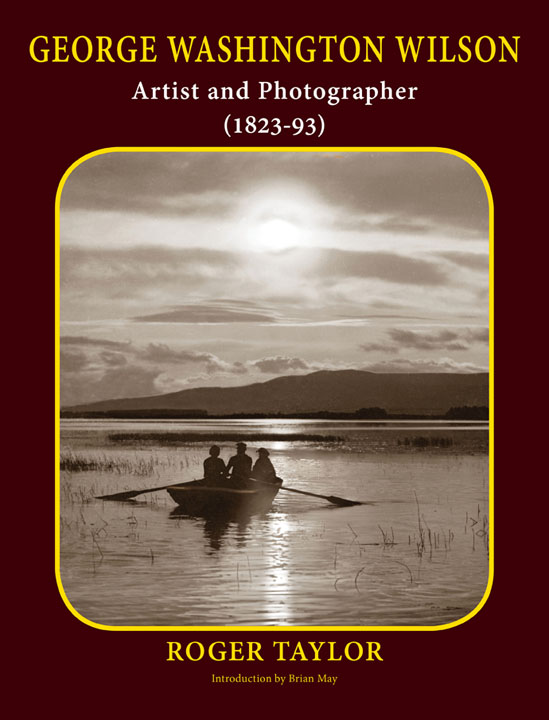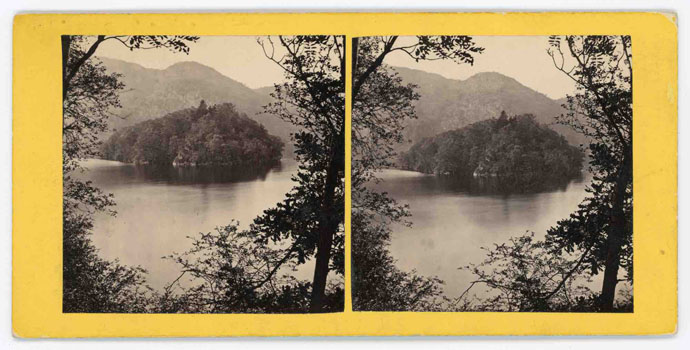
GEORGE WASHINGTON WILSON
Artist and Photographer
(1823-93)
By Roger Taylor
Introduction by Brian May
Publishes on 15 August 2018, £30
www.londonstereo.com
A STEREOSCOPIC MASTERPIECE EXPLORING THE LIFE
AND WORK OF LEADING VICTORIAN PHOTOGRAPHER,
GEORGE WASHINGTON WILSON
“It’s my great pleasure to introduce to you all this beautiful book, at the request of its author, my great friend Professor Roger Taylor. It’s been many years in the making, and I’m confident it will have been worth every minute. It presents the life and work of celebrated Scottish landscape photographer George Washington Wilson, who, with great skill and flair, photographed the unique beauties of the Scottish countryside in the 1860s with his stereoscopic camera. The resulting 3-D images proved immensely successful and established Wilson’s national reputation as a pre-eminent photographer. Now, courtesy of the Lite OWL included with every book, Wilson’s images can be experienced in exactly the same way they were enjoyed by the Victorian public.”
Brian May
When photography was first introduced to Britain in the early 19th century, Scotland adopted the process with great interest and enthusiasm. A leading practitioner was George Washington Wilson whose innovations in stereoscopic photography created some of the most captivating 3-D photographs of the period and established his reputation, both nationally and internationally. He began his career as a portrait miniature painter, but in the early 1850s he took up photography and established a portrait studio in his home town of Aberdeen. One of his earliest commissions was to photograph the construction of the new Balmoral Castle, and the success of these studies led to other assignments, including portrait sessions of Queen Victoria and members of the Royal Family. He was subsequently appointed Photographer to the Queen.
By the 1860’s Wilson had established his national reputation through a series of technical and aesthetic innovations that significantly advanced the art of stereoscopy and topographic photography. As a result, his business as a photographer, publisher and retailer of images for the tourist market rapidly expanded, and within a few years he dominated the field. George Washington Wilson, Artist and Photographer, for the very first time, allows readers to view Wilson’s work in its original three-dimensional format.

Prof Roger Taylor, the world authority on Wilson, traces his career, captures the essence of the man and presents a glorious gallery of his work in colour (from striking landscape imagery to portraits of royals) with over eighty 3-D stereo cards which can be viewed with the complimentary viewer (Lite OWL, designed by Brian May, included with the book).
Brian May is one of the world’s foremost collectors of 3-D photography, and his archive includes many works by George Washington Wilson and in this collaboration with Roger Taylor, he shares images from the collection.
About the author
Prof Roger Taylor has spent his entire professional life working with photography, initially as a commercial and industrial photographer before moving into teaching on the Fine Art course at Sheffield College of Art during the 1960’s. It was here that he became fascinated by the history of the medium and began his research into George Washington Wilson whilst studying for his Masters Degree in Victorian Studies at Leicester University. His commitment to photographic history led to his appointment at the National Museum of Photography, Film and Television, in Bradford, where he was responsible for installation of a new Kodak Museum, which opened in 1989. Seven years later he took early retirement to pursue his researches into mid- Victorian photography, specialising in the emergence of early processes in Britain 1839-1865. Following a number of research fellowships within major collections in Canada and America he was appointed as a Senior Research Fellow at De Montfort University, where he is now Professor Emeritus. In 2014 he was awarded an Honorary Doctorate by the University of Derby in recognition of his significant contributions to photographic history.
About the London Stereoscopic Company and the birth of the OWL
Some time in 1854 ‘The London Stereoscope Company was born. Its business was selling stereo views and viewers to the public, and they were leaders in a huge boom – a craze which swept England, Europe, and eventually the United States too, of stereo photographs of every conceivable subject, which, viewed by means of a stereoscope, presented scenes in life-like three dimensions. In a world which had never experienced Television, the Movies, or the Internet, this was a major sensation. In February 1856, The London Stereoscopic Company (LSC) advertised, in the Photographic Journal, “The largest collection in Europe, upwards of 100,000 stereo views.”
Brian May’s introduction to stereoscopy was as a child finding 3-D cards in his breakfast cereal. In the 1950s Weetabix gave away free coloured stereo cards in their packets, along with an opportunity to send off one-and-sixpence for the stereoscope required to view them. Brian, discovering that he could free-view them without the viewer too, was entranced, and quickly figured out how to make his own stereo views, and was hooked for life. Scouring Portobello Road market for stereoscopic items some years later, Brian discovered the intriguing Diableries cards, which stirred a special passion, which was to lead to the Diableries book 40 years later. While studying Astronomy at Imperial College, Brian became a regular viewer at Christie’s photographic auctions, at the time a rich source of long forgotten stereo views from the 1850s onwards which were turning up in people’s attics. In 2008 Brian realised his dream of recreating The London Stereoscopic Company (LSC), its aim to bring the magic of true stereoscopy to the modern world. In order to share Victorian 3-D, Brian designed his own OWL stereoscope, which is now produced in large quantities. The OWL has become a new standard around the world in stereoscopic viewing. In 2011 Brian met a redoubtable French scholar, Denis Pellerin, one of the world’s experts on French and English Photographic History. Their two passions connected immediately, and Denis became Brian’s curator, conservator, researcher, and co-author. The London Stereoscopic Company is now restoring and republishing Victorian classic cards, as well as original stereoscopic works on other subjects. Finally the LSC completed the picture by entering into book publishing, each new work accompanied by an OWL stereoscope included in the package. George Washington Wilson, Artist and Photographer will be the LSC’s sixth title.
The London Stereoscopic Company is the ONLY publisher in the world dedicated exclusively to publishing stereoscopic works. The LSC’s mission is to share the world’s greatest 3-D images, from Victorian time to present day.
For further information please contact: Nicole@londonstereo.com +44 7515394107 www.londonstereo.com Follow @londonstereo